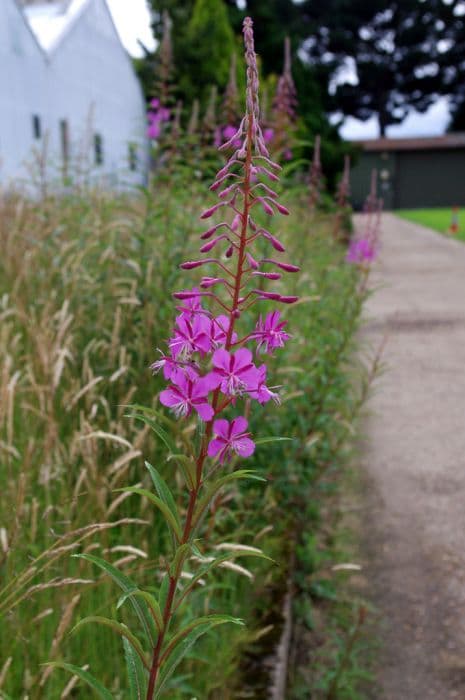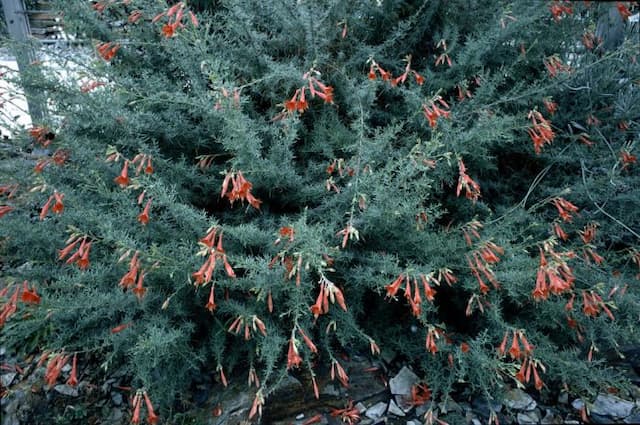Fuchsia Fuchsia 'Micky Goult'

ABOUT
The Fuchsia 'Micky Goult' is a charming flowering plant that is widely admired for its decorative appearance. This plant boasts an array of delightful, pendulous flowers that dangle elegantly from its branches, resembling graceful little lanterns. The blossoms exhibit a stunning combination of colors, generally featuring a deep purple or pink hue that transitions into a paler pink or even white towards the petal edges. At the heart of the flowers, the stamens typically protrude, offering a touch of contrasting color, usually in a deeper shade, which adds to their exquisite charm. The petals are elongated and often display a slight ruffle along their edges, lending a textured look to the overall floral presentation. Beneath the flowers, fuchsia green pointed leaves provide a lush backdrop, setting off the vivid colors of the blooms. The leaves are oval-shaped to slightly elongated, with a gentle serration on the edges that gives them a delicate appearance while also being sturdy. The 'Micky Goult' Fuchsia carries its blooms in generous clusters that invite observers to admire their beauty up close. The flowers are a favorite amongst garden enthusiasts and are known to attract hummingbirds and other pollinators, making this plant not only a visual delight but also an essential contributor to the garden's ecosystem. With its cascading flowers and vibrant colors, the Fuchsia 'Micky Goult' is a standout plant that adds a spectacular burst of color and life wherever it is grown.
About this plant
 Names
NamesFamily
Onagraceae.
Synonyms
Ladies' Eardrops, Fairy Bells, Hummingbird Fuchsia.
Common names
Fuchsia 'Micky Goult'.
 Toxicity
ToxicityTo humans
Fuchsia, including the 'Micky Goult' variety, is generally considered non-toxic to humans. Most fuchsias, including their berries and flowers, are edible and sometimes used in culinary dishes for their mildly acidic flavor. However, as with any plant, individual allergic reactions or sensitivities can occur, so it is advised to proceed with caution when trying any new plant for the first time.
To pets
Fuchsia, including the 'Micky Goult' variety, is typically non-toxic to pets such as cats and dogs. The plant is not listed among those commonly known to be poisonous to domestic animals. Therefore, if a pet ingests part of a fuchsia plant, there are likely no toxic effects to be expected. Nonetheless, overconsumption of non-food items can lead to gastrointestinal upset in pets, so it's always a good idea to monitor your pets and keep houseplants out of their reach if they are known to chew on plants.
 Characteristics
CharacteristicsLife cycle
Perennials
Foliage type
Deciduous
Color of leaves
Green
Flower color
Mixed
Height
2 feet (0.61 meters)
Spread
2 feet (0.61 meters)
Plant type
Shrub
Hardiness zones
9
Native area
Central America
Benefits
 General Benefits
General Benefits- Ornamental Appeal: Fuchsia 'Micky Goult' has striking flowers that enhance the visual aesthetics of gardens and landscapes.
- Attracts Pollinators: The vibrant flowers attract bees, butterflies, and hummingbirds, aiding in pollination of plants within the area.
- Shade Tolerance: It can thrive in shaded areas where other plants may struggle, providing gardeners with more planting options.
- Container Gardening: This variety does well in pots and hanging baskets, making it suitable for balconies, patios, and indoor settings.
- Long Blooming: Fuchsia 'Micky Goult' often has a lengthy blooming period, providing extended seasonal interest.
- Easy to Propagate: It's relatively easy to propagate from cuttings, allowing gardeners to create new plants without additional cost.
 Medical Properties
Medical PropertiesThis plant is not used for medical purposes.
 Air-purifying Qualities
Air-purifying QualitiesThis plant is not specifically known for air purifying qualities.
 Other Uses
Other Uses- Fuchsia can be utilized as a natural dye for fabrics, providing a subtle pinkish or purplish hue depending on the concentration and the type of fabric used.
- Create a visually appealing edible garnish for desserts and salads, as some fuchsia flowers are edible, adding both color and a slight citrusy flavor to dishes.
- Use in horticultural therapy settings, as the intricate flowers and the act of caring for fuchsias can provide a calming and therapeutic activity for individuals.
- Incorporate fuchsia plants in a butterfly or hummingbird garden, as their tubular flowers are attractive to these pollinators and can help promote local biodiversity.
- Employed in craft projects, such as making pressed flowers for decorative artworks or in creating natural confetti for weddings and celebrations.
- Fuchsias can be used in educational settings to teach children about plant biology and botany, especially the process of pollination and flower development.
- As a living gift that keeps on giving, a potted fuchsia can be a thoughtful and sustainable alternative to cut flowers for special occasions.
- Incorporate fuchsia plants into a sensory garden, as their vivid colors, interesting shapes, and textures can provide a stimulating and enriching experience.
- Fuchsia branches and flowers may be used in floral arrangements and wreaths, offering a unique texture and splash of color that differs from traditional foliage.
- Collect fuchsia seed pods for a seed exchange program, encouraging diversity and the sharing of unique plant varieties within a community of gardeners.
Interesting Facts
 Feng Shui
Feng ShuiThe Fuchsia is not used in Feng Shui practice.
 Zodiac Sign Compitability
Zodiac Sign CompitabilityThe Fuchsia is not used in astrology practice.
 Plant Symbolism
Plant Symbolism- Grace – The Fuchsia plant, with its elegant hanging flowers, is often associated with gracefulness and poise.
- Good Taste – The lovely appearance and colors of the Fuchsia reflect a sense of refinement and good taste.
- Confiding Love – In the language of flowers, a Fuchsia can signify a deep love that's being confided.
- Ardent Affection – The Fuchsia’s vibrant colors and growth pattern can represent strong emotional bonds and earnestness in a relationship.
 Water
WaterFuchsia 'Micky Goult', commonly known as Hardy Fuchsia, should be watered thoroughly, ensuring the soil is moist but not waterlogged. During the growing season, water it with about 1 to 2 gallons per week, divided into smaller waterings every few days. Adjust frequency based on weather conditions; reduce watering in cool, rainy periods, and increase it during hot, dry spells. Always check the top inch of the soil for dryness before the next watering. Overwintering plants need less water, but the soil should not be allowed to dry out completely.
 Light
LightHardy Fuchsia thrives best in a location where it receives morning sunlight and afternoon shade, protecting it from the hot midday sun. An eastern-facing spot with dappled light is ideal for promoting abundant blooms without causing heat stress. Ensure the plant gets at least 4 to 6 hours of light per day for optimal growth.
 Temperature
TemperatureHardy Fuchsia prefers a temperate climate with temperatures ranging between 60°F and 75°F, which are ideal for growth. They can withstand a minimum temperature of about 40°F and a maximum of around 85°F. These conditions help the plant maintain its lush foliage and vibrant blooms.
 Pruning
PruningPrune Hardy Fuchsia in the early spring to maintain shape and promote vigorous growth. Removing dead or damaged branches and cutting back up to one-third of the plant encourages new blooms and denser foliage. Timely pruning, ideally after the last frost, also helps prevent disease by improving air circulation within the plant.
 Cleaning
CleaningAs needed
 Soil
SoilFor the best soil mix for Fuchsia 'Micky Goult,' create a blend of one part peat moss or a peat-based potting soil to one part loam and one part perlite or sand for drainage. The ideal pH for this plant's soil is slightly acidic to neutral, around 6.0 to 7.0.
 Repotting
RepottingFuchsia 'Micky Goult' should be repotted annually in the spring, before the onset of new growth. If the plant has become too large or the soil is exhausted, repotting can help maintain health and vigor.
 Humidity & Misting
Humidity & MistingFuchsia 'Micky Goult' flourishes in high humidity conditions, ideally between 60% and 70%. This mimics their natural habitat and helps maintain healthy growth and flowering.
 Suitable locations
Suitable locationsIndoor
Provide indirect light, high humidity, and regular watering.
Outdoor
Shelter from strong winds, partial shade, and protect from frost.
Hardiness zone
9-11 USDA.
 Life cycle
Life cycleFuchsia 'Micky Goult', commonly known as hardy fuchsia, begins its life cycle with seed germination, typically in a warm and moist environment. Once the seedlings have emerged, they grow into young plants, establishing a root system and producing their first sets of true leaves. As the plant matures, it enters a vegetative stage, developing branches and an abundance of dark green foliage. During the flowering stage, the plant produces distinctive, pendulous flowers with pink, purple, and white hues, attracting pollinators such as bees and hummingbirds. After pollination, the fuchsia produces small fruit that contain seeds, completing its reproductive cycle. During the dormant season, especially in cooler climates, the fuchsia may lose its leaves and die back to the ground, but with proper care, it can regrow from its root system the following spring.
 Propogation
PropogationPropogation time
Spring-Summer
The Fuchsia 'Micky Goult', commonly known as hardy fuchsia or lady's eardrops, is commonly propagated through softwood cuttings. The best time for this is late spring to early summer when new growth is green and pliable. To propagate, one would take cuttings of about 2 to 4 inches (5 to 10 cm) in length from the tip of the plant. Each cutting should have at least two sets of leaves, and the lower leaves are removed to expose a length of stem that can be inserted into a rooting medium, such as a mixture of peat and perlite. The stem cutting should be dipped into rooting hormone before being placed in the medium to encourage root development. The cuttings are then kept in a warm, humid environment out of direct sunlight until roots have developed, which typically takes a few weeks. Once rooted, the cuttings can be transplanted into individual pots and gradually acclimated to outdoor conditions if needed.









